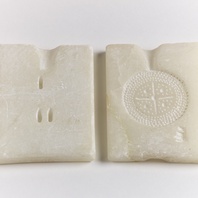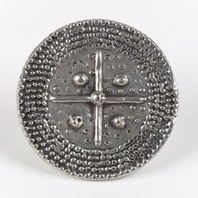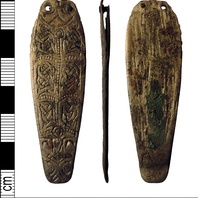
Viking Objects
Reproduction Soapstone Mould
A soapstone (steatite) mould for casting jewellery. This reproduction is double-sided so that it can be used to cast the main brooch or two disc brooches simply by reversing the mould. It is based on known examples of soapstone moulds but the main mould has been created to reproduce the Barker Gate brooch from Nottingham. Soapstone or steatite was widely used in Scandinavia and the Viking diaspora, as it is soft and easily carved, in particular for cooking vessels in cultures that did not produce ceramics. There are soapstone quarries in Norway, Shetland and Greenland. Soapstone objects found elsewhere generally suggest a Viking link to one of these places, though smaller ones are often repurposed from what were originally larger vessels.
Read More

Viking Objects
Reproduction Lead Alloy Brooch
A reproduction of an early medieval, lead alloy brooch found at Barker Gate, Nottingham. Brooches were a typical part of female dress. Scandinavian brooches came in a variety of sizes and shapes which included disc, trefoil, lozenge, equal-armed, and oval shapes. The different brooch types served a variety of functions in Scandinavian female dress with oval brooches typically being used as shoulder clasps for apron-type dresses and the rest being used to secure an outer garment to an inner shift. Anglo-Saxon brooches do not match this diversity of form with large disc brooches being typical of ninth century dress styles with smaller ones becoming more popular in the later ninth and tenth centuries. However, since disc brooches were used by both Anglo-Saxon and Scandinavian women they are distinguished by their morphology. Scandinavian brooches were typically domed with a hollow back while Anglo-Saxon brooches were usually flat. Moreover, Anglo-Saxon brooches were worn singly without accompanying accessories.
Read More

Viking Objects
Anglo-Saxon Zoomorphic Strap-End (NCMG 2003-27; T2001:2 ; 2002 T21)
A large silver strap-end with simple chevron decoration and six incised panels of ribbon knotwork divided by curved laddered frames. This strap-end is typical of ninth-century Anglo-Saxon design from the Yorkshire school. The border design is also found on the Trewhiddle type but due to its lower quality execution this strap-end is probably an imitation. Strap-ends came in various styles and were fairly common throughout the Viking world. They were used to decorate the ends of belts and to stop them getting damaged.
